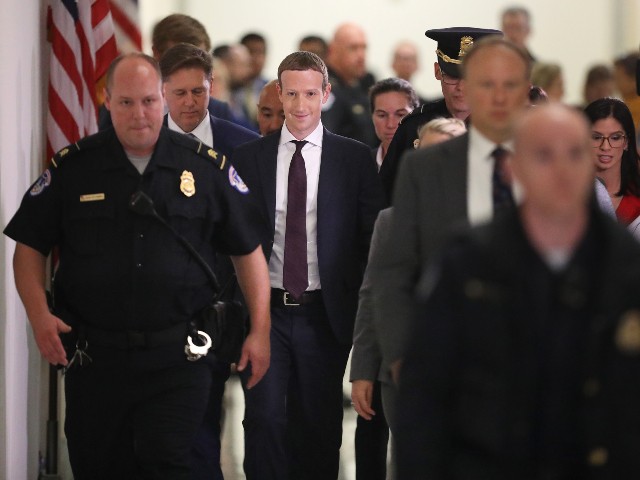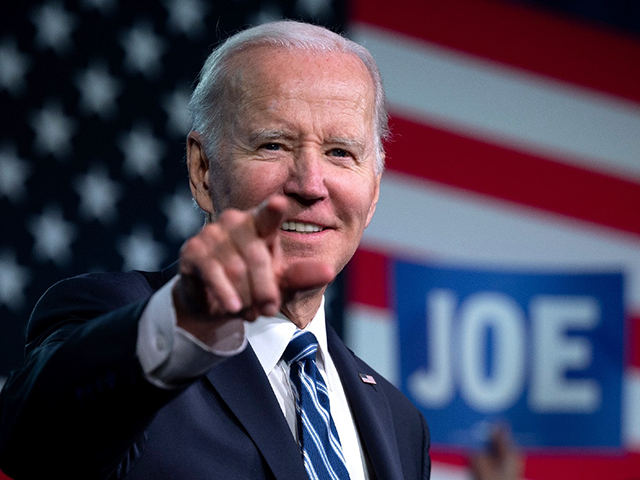Thanks to leaks, lawsuits, the Twitter Files, and congressional inquiry, the sheer size and complexity of the “disinformation” industry is starting to be exposed.
Enormous in scope, the censorship machine that has made a mockery of the First Amendment was driven by powerful forces that went far beyond the Silicon Valley tech companies themselves — though they are major culprits.

Mark Zuckerberg surrounded by guards (Chip Somodevilla /Getty)

Hungarian-born U.S. investor and philanthropist George Soros smiles after delivering a speech on the sidelines of the World Economic Forum (WEF) annual meeting in Davos on May 24, 2022. (FABRICE COFFRINI/AFP via Getty Images)
Corporate media companies, billionaire philanthropists and foundations, academics, associations, and the deep state all joined forces to create a vast, international web of organizations that conspired to suppress Americans’ free speech rights, and the free speech of people around the globe in the form of so-called “disinformation” experts.
The tech companies, uncertain about the U-turn on their previously-stated commitments to free speech, initially tried to hide what they were doing, and had to be exposed: Breitbart News’ publication of leaks from inside Google, such as “The Good Censor” and YouTube’s search blacklists, gave the public a glimpse behind the curtain.
However, as time went on, the censorship machine began conducting its affairs out in the open, proudly trumpeting the crusade against “disinformation” online.
Virtually nonexistent before 2016, the cottage industry of “disinformation studies” exploded following Donald Trump’s victory over Hillary Clinton. In the weeks following Trump’s win, the media was crying foul; blaming hoax news stories and Russian bots masquerading as Trump supporters for the defeat of their favored candidate.
“Fake news,” the buzzword of choice that would eventually be replaced with “disinformation,” became the media’s top story. The media-led panic was so effective, that within days of Trump’s election, Google employees were asking their executives what the company planned to do about the “fake news” shared by “low information voters.” That’s double-speak for people who vote the “wrong” way, i.e., for conservatives. At Facebook, Mark Zuckerberg initially dismissed the idea that Trump voters had simply been duped by misinformation — and instantly faced a mutiny from his own employees.
With the scapegoat thus identified, the money started pouring in. Less than six months into Trump’s first term, leftist billionaire Pierre Omidyar committed $100 million to fight the “fake news” boogeyman. Reid Hoffman, the LinkedIn founder, went further, funding a group that actively spread misinformation during the 2017 Alabama runoff election.
Hoffman would later team up with George Soros to create an incubator for businesses and organizations combating disinformation. Craig Newmark, of Craigslist fame, also spent close to $100 million funding various leftist journalism and “fact checking” outfits. In interviews, Newmark said he was motivated by the 2016 election, and by reading a NATO handbook on “foreign disinformation.”
The NATO handbook was not an isolated incident. During the Trump administration and even after, the deep state gave its full encouragement to the “disinformation” panic, recognizing an opportunity to reassert control over public discourse in the United States — control that was so readily available while a few big media companies held a monopoly on public attention, but had since been splintered by the rise of social media.
As the Federalist reported last month, the federal government gave over five hundred grants and awards to projects that dealt with “misinformation” or “disinformation” between 2016 and 2023. It granted just two federal contracts and seven federal grants to the same in the previous eight fiscal years. The election of Trump was a turning point for the Left; it pounced on the “disinformation” panic in a frantic effort to tame dissent.
It was not alone. Following the election of Trump, an unstoppable array of special interests joined forces to impose censorship across the web and snuff out the independent media.
The Corporate Media
2016 was a crisis year for the corporate media. While legacy publishers didn’t do badly during the election year (in fact, ratings boomed), conservative media — Breitbart News, chief among them — was nipping at their heels. It was the culmination of decades of online disruption, beginning in the 1990s with The Drudge Report, which allowed conservative publishers to make national issues out of stories the legacy media would rather ignore.
It also coincided with preexisting trends that were profoundly threatening to the legacy media. Independent podcasters and social media influencers were attracting larger and younger audiences than cable news hosts with multi-million dollar budgets. Advertisers were racing away from traditional media to platforms like Google and Facebook, which offered unbeatable personalization. And, making its founder Craig Newmark’s later commitments to rescue the media all the more ironic, Craigslist had destroyed the viability of newspaper classified ads. Everywhere it turned, the corporate media faced threats to its relevance.
The election of Trump and the scare over “Russian” disinformation on social media gave the media the opportunity to fight back. Fact checkers were elevated to a new role as watchdogs of online information, identifying for the tech giants what content ought to be suppressed and what ought to be elevated. Some were media companies themselves, empowered to suppress their competition on social media. Facebook’s third-party fact checkers in the U.S. now include the Associated Press, USA Today, AFP, Reuters, and the Dispatch — all media companies with strong ideological and material incentives to suppress conservative media. Yes, media companies were put in charge of fact-checking their business competitors — an obvious conflict of interest that would not be tolerated almost anywhere else.
Organizations like NewsGuard went a step beyond the fact-checkers. Not content with assessing the credibility of individual stories and claims, the organization purported to rank the credibility of entire news outlets. Much like the disgraced Global Disinformation Index (GDI), NewsGuard rankings are now effectively a blacklist of conservative websites. Breitbart News, The Federalist, Newsmax, One America News, The Epoch Times, Red State — all are on GDI’s blacklist, and NewsGuard advises “caution” or “maximum caution” to anyone dealing with the websites.
A recipient of Pentagon funding, NewsGuard markets its blacklist to tech companies, advertisers, and classrooms across America. It launched with a Microsoft partnership, which installed it by default in Edge mobile browsers, launched a “BrandGuard” service to advise advertisers on “risky” brands, and partnered with the American Federation of Teachers (AFT), which agreed to purchase licenses for all of its 1.7 million represented teachers.
Cooperation from the tech giants, who after a brief period of resistance agreed to integrate “fact checkers” into their new censorship regime, was not enough for the media companies. Initially led by Rupert Murdoch’s Newscorp, media lobbyists around the world embarked on an effort to force tech companies to support them with advertising revenue, and deepen the censorship of their competitors. In the U.S., one way these efforts materialized was in the form of the Journalism Competition and Preservation Act (JCPA), a bill marketed as a fix for “misinformation,” which would allow a cartel of big media companies to extract payments from tech companies for the privilege of carrying their content.
With their business model and audience under threat, media companies used the Trump election to create a new role for themselves — arbiters of truth in a world flooded by online alleged “misinformation.” The key is that what they labeled “misinformation” was often not, but rather opinion or reporting that they disagreed with on ideological or partisan grounds.
The Security State
In their efforts to censor social media and reassert their dominance over the national discourse, the media had a powerful ally in the form of the national security state. After 2016, the national security deep state, together with organizations focused on foreign policy and national security, pivoted to a focus on disinformation and misinformation.
The Atlantic Council (a major recipient of U.S. State Department funding), and the German Marshall Fund (funded by the U.S., German, and Swedish governments, as well as Omidyar, Soros, and Newmark) are two prominent examples of foreign policy-focused organizations, highly integrated with the U.S. security deep state, that went all-in on the disinformation panic.
One project of the German Marshall Fund, called the Alliance for Securing Democracy (ASD), proved particularly influential due to its creation of the Hamilton 68 dashboard. The project of a former FBI agent, Clint Watts, Hamilton 68 purported to identify promoters of Russian disinformation on social media. Twitter quickly discovered that these claims were false — the accounts identified by Hamilton 68 were overwhelmingly American conservatives and Trump supporters. But Twitter chose not to expose this, and Hamilton 68 went on to be cited by Rep. Adam Schiff and Sens. Dianne Feinstein, Richard Blumenthal, and Sheldon Whitehouse in their condemnations of “Russian” influence operations on Twitter, which were used to pressure the company to engage in more censorship.
The Global Engagement Center, an arm of the U.S. State Department took a particularly active role in funding anti-disinformation efforts. It awarded the Global Disinformation Index a $100,000 grant, and helped fund the State Department’s “Disinfo Cloud,” a now-retired program to address the “propaganda and disinformation challenges” of the U.S. and its allies. Even that didn’t hold a candle to the Department of Defense, which gave millions of dollars to the shadowy AI-powered social media mapping company Graphika (a member of the EIP), including a $3 million grant to research “Cross-Platform Detection to Counter Malign Influence.”
Academic Institutions
Similarly threatened by the web’s democratization of information, and eager to chase the vast amounts of grants and funding for “disinformation studies” that were now on offer from both the government, leftist billionaires and foundations, academia quickly began contributing to the censorship machine.
Clemson University, Harvard’s Berkman Klein Center, the MIT Media Lab, the Oxford Internet Institute, and the Election Integrity Partnership (EIP) headed by Stanford University were among the most notorious. The latter, a coalition that included the Atlantic Council’s Digital Forensics Research Lab and the University of Washington’s Center for an Informed Public, played a leading role in online censorship during the 2020 election, closely cooperating with the deep state.
In the runup to 2020, the consortium created a “ticketing” system whereby U.S. government actors including the Department of Homeland Security and the State Department could escalate complaints to social media companies. The EIP claims that in 21 percent of cases, platforms added warning labels to identified content, and in 13 percent of cases, the content was removed from the platforms entirely.
Woke Advertisers
The media and left-wing activists discovered very early on that when social media companies wavered on censorship, advertisers could give them the necessary shove. Some organizations, like Sleeping Giants, openly broadcasted their intentions to target conservative media with advertiser boycotts. Others were more subtle.
The Global Disinformation Index (GDI) and NewsGuard are among the more subtle. Both present themselves to the public as non-partisan and non-ideological, only concerned with accuracy and high journalist rather than stopping “hate.” But both reveal their intentions in their explicit targeting of digital advertisers – and, in the case of NewsGuard, doing so for profit. GDI worked with Xandr, Microsoft’s advertising platform, giving advertisers a list of (overwhelmingly conservative) websites that it considered risky bets for advertising. NewsGuard, which is also closely tied to Microsoft, does the same with its “BrandGuard” service, advertised as a means for companies from advertising with “untrustworthy domains that spread dangerous misinformation.”
Advertiser pressure campaigns have been used not just to rob conservative websites of ad revenue, but to censor social media. Independent creators on YouTube arguably never recovered from the 2017 “adpocalypse,” a turning point in ad boycotts that saw hundreds of millions of dollars in ad spending withdrawn from the platform after the media whipped up panic about ads appearing next to “hate speech” and “extremism” on the Google-owned platform. The media tried to do the same to Facebook ahead of the 2020 election — whipping up an ad boycott to pressure the company for even more censorship.
The corporate advertisers themselves were not passive actors in all this. Just a few weeks after Trump’s inauguration in 2017, the CEO of the Interactive Advertising Bureau, a trade association for digital advertisers that includes some of the world’s leading brands, was calling on members to immediately rid the “digital marketing and media supply chain” of “fake news.”
Unraveling the Censorship Complex
There are signs that the tide is turning against the censorship complex. The pausing of the DHS “Disinformation Board” and its leader, Nina Jankowicz, the failure of Joe Biden’s pro-censorship FCC nominee Gigi Sohn to secure a Senate confirmation, and ongoing lawsuits from red states against the federal government over the latter’s involvement in censorship are creating a significant counterweight to the “disinformation” regime.
Nevertheless, the post-2016 empire of disinformation censorship remains vast and well-funded, and extends far beyond the federal government. Its influence can be felt in virtually every tech company, academic institution, and government agency. There are now hundreds of “disinformation” watchdogs like NewsGuard and GDI, which work tirelessly to suppress non-progressive viewpoints, and harm the business models that support them. To unravel, expose, and neuter this regime, Republicans must commit at least the same amount of time and resources that their opponents spent in creating it.
Allum Bokhari is the senior technology correspondent at Breitbart News. He is the author of #DELETED: Big Tech’s Battle to Erase the Trump Movement and Steal The Election.

COMMENTS
Please let us know if you're having issues with commenting.